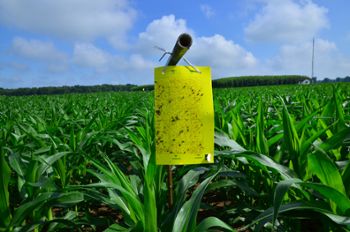Novel windows through time open fresh views of long-term research
Just over 40 years ago, the National Science Foundation (NSF) posited a visionary idea: the establishment of a national network of Long Term Ecological Research (LTER) sites. Today, these 28 sites carry an unprecedented database of decades-long ecological observations and experiments.
Michigan State University’s LTER site, located at the W.K. Kellogg Biological Station (KBS) near Battle Creek, Mich., was founded in 1988 to employ and understand the ecology of Midwest cropping systems and agricultural landscapes. Researchers study interactions among plants, microbes, insects, management, and the environment to learn how agriculture can provide both high yields and environmental outcomes that benefit society.

When KBS passed the 30-year mark in 2018, three former KBS researchers, Sarah Cusser and Jackson Helms, both former postdoctoral researchers in integrative biologist Nick Haddad’s lab, and Christie Bahlai, former postdoctoral researcher working with integrative biologist Elise Zipkin and entomologist Doug Landis, decided the 30th anniversary was not only a significant milestone, but a good time to ask questions about LTER's database.
“LTER sites have this tremendous amount of data over a long time series, which is every postdoc’s dream,” said Cusser, lead author of the postdoc-led paper recently published in Ecology Letters. “We took this beautiful, broad data and looked at little windows to see how consistent it is.”
Bahlai was responsible for designing the brilliant approach to sampling subsets of decades-long data that she dubbed a moving windows algorithm. The algorithm frames out 3- to 5-year time spans inside larger datasets, enabling the scientists to separate out real, long-term trends from errant blips in an ecological timeline.
“The algorithm takes these long stretches of data and says, instead of 30 years, what if we only looked at it from 1992-1995, or any segment of that 30 years, would we get the same answers?” explained Cusser, who showed in an earlier paper that research windows less than 10 years at KBS were insufficient to see the ecological and economic benefits of no-till agriculture.
“Jackson and I wondered, what if we applied this idea to the entire LTER?” Cusser said. “Then we thought, that’s ridiculous, it would take forever. Eventually, we decided to make an attempt at a subset of the LTER data.”
Beginning in 2018, the researchers began sifting through LTER sites to find ones that employed similar methodological approaches. After virtually touring the vast and diverse network, the team narrowed their sample down to 100 of the nearly 9,000 datasets.
“I never thought I would work with nematodes in Antarctica or kelp in Santa Cruz,” said Cusser, whose Ph.D. research focused on ecosystem services in cotton crops. “But all of these totally disparate datasets had two things in common: they were long-term experiments, and they recorded changes in organismal abundance over time.”
The researchers hypothesized that, among the 22 sites included in the study, highly seasonal abiotic environments such as the Arctic or Antarctic would need more time than low variability abiotic environments to see consistent results. The researchers also predicted that organisms that took a long time to grow or dispersed slowly, such as plants, would require more time for consistent results than organisms that reproduced and moved quickly, like small mammals.
The simple answer to their long-term dataset question was that 9.66 years was the critical time threshold to achieve consistent, significant results.
Read more at NatSci.



